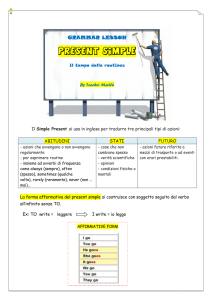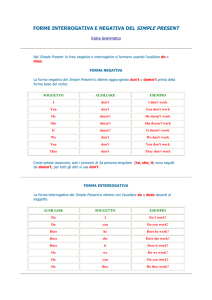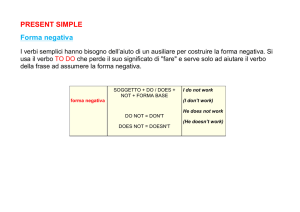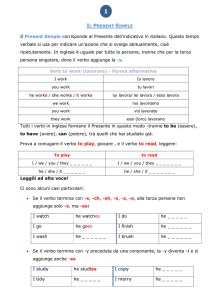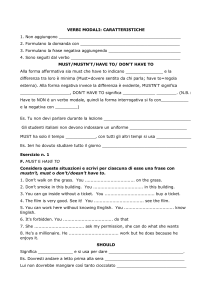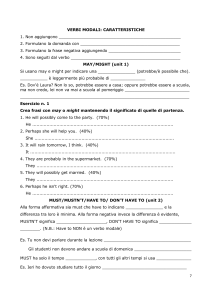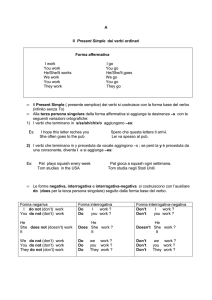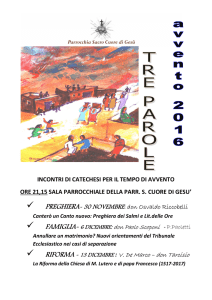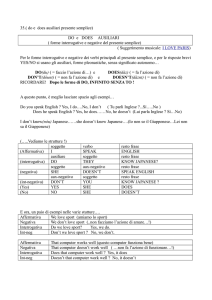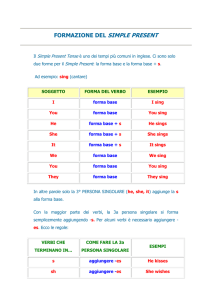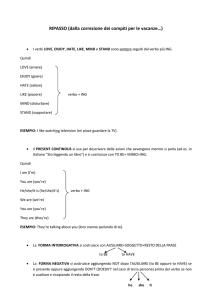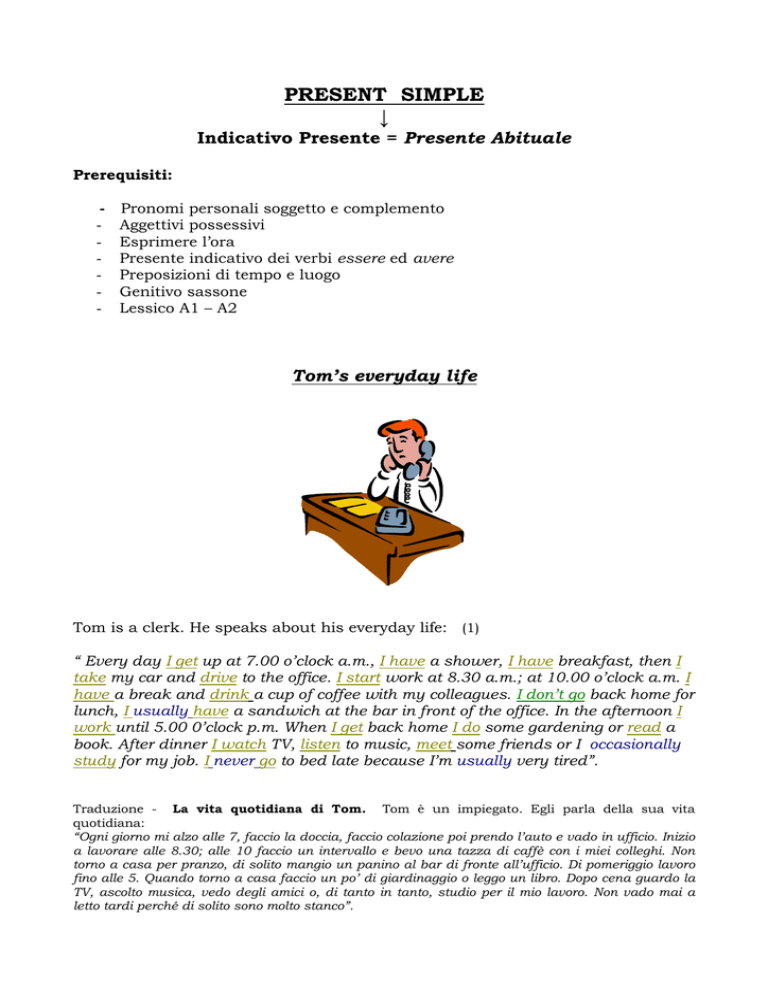
PRESENT SIMPLE
↓
Indicativo Presente = Presente Abituale
Prerequisiti:
-
Pronomi personali soggetto e complemento
Aggettivi possessivi
Esprimere l’ora
Presente indicativo dei verbi essere ed avere
Preposizioni di tempo e luogo
Genitivo sassone
Lessico A1 – A2
Tom’s everyday life
Tom is a clerk. He speaks about his everyday life: (1)
“ Every day I get up at 7.00 o’clock a.m., I have a shower, I have breakfast, then I
take my car and drive to the office. I start work at 8.30 a.m.; at 10.00 o’clock a.m. I
have a break and drink a cup of coffee with my colleagues. I don’t go back home for
lunch, I usually have a sandwich at the bar in front of the office. In the afternoon I
work until 5.00 0’clock p.m. When I get back home I do some gardening or read a
book. After dinner I watch TV, listen to music, meet some friends or I occasionally
study for my job. I never go to bed late because I’m usually very tired”.
Traduzione - La vita quotidiana di Tom. Tom è un impiegato. Egli parla della sua vita
quotidiana:
“Ogni giorno mi alzo alle 7, faccio la doccia, faccio colazione poi prendo l’auto e vado in ufficio. Inizio
a lavorare alle 8.30; alle 10 faccio un intervallo e bevo una tazza di caffè con i miei colleghi. Non
torno a casa per pranzo, di solito mangio un panino al bar di fronte all’ufficio. Di pomeriggio lavoro
fino alle 5. Quando torno a casa faccio un po’ di giardinaggio o leggo un libro. Dopo cena guardo la
TV, ascolto musica, vedo degli amici o, di tanto in tanto, studio per il mio lavoro. Non vado mai a
letto tardi perché di solito sono molto stanco”.
Then he speaks about his wife’s everyday life. Sheila is a successful
businesswoman: (2)
“ Sheila gets up very early in the morning because, for her job, she often travels to
other cities. She usually travels by plane so she takes a taxi and goes to the
airport. She doesn’t have breakfast at home; if she is early for her flight, she has a
cup of black coffee before getting on board. She usually comes back in the evening
but, sometimes, she stays away overnight. When she is at home, she’s always
busy and we spend very little time together….”
Traduzione – Poi parla della vita quotidiana di sua moglie. Sheila è una donna d’affari di successo:
“Sheila si alza molto presto al mattino perché, a causa del suo lavoro, ella va spesso in altre città. Di
solito ella viaggia in aereo così prende un taxi e va all’aeroporto. Ella non fa colazione a casa; se è in
anticipo per il volo, ella prende una tazza di caffè prima di salire sull’aereo. Di solito torna la sera
ma, talvolta, rimane fuori due giorni. Quando è a casa ha sempre molto da fare così trascorriamo
molto poco tempo insieme…”
Il PRESENT SIMPLE si usa principalmente:
▪ per esprimere azioni abituali
▪ con funzione di presente narrativo
A differenza dell’italiano, la coniugazione dei verbi (tranne essere, avere e verbi
modali aventi una propria coniugazione) nella forma affermativa è estremamente
semplice in quanto si usa la forma base (= infinito senza to ) tranne per la terza
singolare dove si aggiunge la desinenza –s alla forma base stessa.
Forma affermativa
I
Drive
You
Drive
He, She, It Drives
We
Drive
You
Drive
They
Drive
L’aggiunta della desinenza –s per la terza persona singolare comporta talvolta
variazioni ortografiche dipendenti dalla terminazione del verbo:
- Se il verbo termina in –s, -ss, -sh, -ch, -x, -z, -o si aggiunge –es
- Se il verbo termina in –y preceduta da consonante, la y cambia in i e
aggiunge –es, mentre quando la y è preceduta da vocale aggiunge
normalmente la –s.
Esempi: Tom watches TV after dinner. He never goes to bed late. In the evening he
studies for his job. Ma: Sheila sometimes stays away overnight.
Study → studies (y preceduta da consonante)
Stay → stays
(y preceduta da vocale)
Per quanto riguarda, invece, le forme interrogativa e negativa, si ricorre all’uso
degli ausiliari do / does che non hanno un corrispondente italiano.
N.B. Do, oltre ad essere ausiliare, è anche verbo principale con il significato di
fare.
Forma negativa
I
do not /don’t
You
do not /don’t
He, She, It does not /doesn’t
We
do not /don’t
You
do not /don’t
They
do not /don’t
go
go
go
go
go
go
Come si vede dalla tabella, gli ausiliari don’t e doesn’t (rispettivamente forme
contratte di do not e does not) sono seguiti dalla forma base del verbo.
Esempi: I don’t go back home for lunch. (tr. Non torno a casa per pranzo)
Sheila doesn’t have breakfast at home. (tr. Sheila non fa colazione a casa)
Forma interrogativa
Do
I
take?
Do
you
take?
Does he, she, it take?
Do
we
take?
Do
you
take?
Do
they
take?
Come si vede dalla tabella, gli ausiliari do e does sono seguiti dalla forma base
del verbo.
Esempi:1. Do Tom and Sheila spend much time together? (tr. Tom e Sheila
trascorrono molto tempo insieme?)
2. Does Sheila have breakfast at home? (tr. Sheila fa colazione a casa?)
Alle suddette domande è possibile rispondere in forma breve (short answers ) sia
in modo affermativo, sia negativo. Tali risposte corrispondono in pratica
all’italiano Sì / No.
1. Yes, they do.
2. Yes, she does.
/
/
No, they don’t.
No, she doesn’t.
In pratica, le short answers si formulano nel seguente modo:
-
risposta affermativa: Yes + pronome personale soggetto + do / does.
-
risposta negativa: No + pronome personale soggetto + don’t / doesn’t.
Forma interrogativa – negativa
Don’t
I
spend?
Don’t
you
spend?
Doesn’t he, she, it spend?
Don’t
we
spend?
Don’t
you
spend?
Don’t
they
spend?
Come già visto per le forme interrogativa e negativa, l’ausiliare doesn’t è seguito
dalla forma base del verbo.
Esempi. Doesn’t Sheila have breakfast at home?
Don’t they spend much time together?
Gli avverbi di frequenza often (spesso), usually (di solito), always (sempre), never
(mai), generally (generalmente), sometimes* (talvolta), seldom / rarely (raramente),
occasionally (ogni tanto), hardly ever (quasi mai) hanno una posizione obbligata
all’interno della frase: si collocano tra il soggetto ed il verbo ad eccezione di
essere, verbi modali ed ausiliari
Esempi: I usually have a sandwich. I occasionally study for my job.
Ma: I’m usually very tired. She’s always busy.
•
Sometimes si può anche collocare ad inizio frase.
Esempio: Sometimes Sheila stays away overnight.
ESERCIZI
a. Coniugare il verbo tra parentesi al Simple Present:
1. The boys (to go) ………………………… to school by bus.
2. Sheila often (to travel) ………………………………. by plane.
3. He (to read) ………………………….. lots of books every year.
4. Mary and Mark (to like) …………………… playing tennis.
5. You and I (to drink) …………………….. milk.
6. Mr Lee (to live) ………………………. in China.
7. We (to come) ………………………. back home very late at night.
8. My husband (to listen) ………………… to the news in the morning.
9. Sam and Cathy (to have) …………………. a nice flat.
10. Students (to learn) …………………….. foreign languages at
school.
( Punti 10 )
b. Volgere le frasi dell’esercizio precedente in forma negativa:
1. The boys ………………………………….. to school by bus.
2. Sheila …………..………………………………. by plane.
3. He ………..………………………….. many books every year.
4. Mary and Mark ………..…………………… playing tennis.
5. You and I ……….…………………….. milk.
6. Mr Lee ………………………………………. in China.
7. We ………………………………. back home very late at night.
8. My husband …………………………… to the news in the morning.
9. Sam and Cathy ……….…………………. a nice flat.
10. Students …….…………………….. foreign languages at school.
( Punti 20 )
c. Volgere le frasi dell’esercizio a. in forma interrogativa:
1. ……………………………………………………. to school by bus?
2. ……………………………………………………. by plane?
3. ……………………………………………….. many books every year?
4. ………………………………………………… playing tennis?
5. …………………………………………………….. milk?
6. …………………………..………………………. in China?
7. …………………….………………………. back home very late at night?
8. ………………………..………………… to the news in the morning?
9. ………………………………..…………………. a nice flat?
10. ………………………………………….. foreign languages at school?
( Punti 20 )
d. Riordinare le parole in modo da formare frasi di senso compiuto
coniugando il verbo al Simple Present e aggiungendo l’ausiliare
dove necessario:
1. water / they / drink / never
………………………………………………………………………..
2. here / eat / he / sandwich / usually / a
………………………………………………………………………..
3. sometimes / Paul / a / drive / motorbike?
………………………………………………………………………..
4. and / you / speak / well / French / I /?
………………………………………………………………………...
5. not / lunch / have / they / generally / home / at
…………………………………………………………………………
( Punti 10 )
e. Rispondere alle seguenti domande con short answers:
1.
2.
3.
4.
5.
Does Sheila have a black cat?
Do they live in London?
Do Mary and Sam eat apples?
Do you play the guitar?
Do we ever drink coffee with milk?
Yes, …………………………………
No, ………………………………….
Yes, ………………………………….
Yes, ………………………………….
No, …………………………………..
( Punti 10 )
f. Facendo riferimento ai testi (1) e (2), formulare risposte complete
per le seguenti domande:
1. What time does Tom get up?
…………………………………………………………………………………………
2. What does he do then?
…………………………………………………………………………………………
3. Does he go to work by bus?
…………………………………………………………………………………………
4. What does he do at 10 o’clock?
…………………………………………………………………………………………
5. What does he have for lunch?
…………………………………………………………………………………………
6. What does he do when he gets back home?
…………………………………………………………………………………………
7. Does Sheila sleep until late in the morning?
…………………………………………………………………………………………
8. Why does she often go to the airport?
…………………………………………………………………………………………
9. Does Sheila sleep at home every night?
…………………………………………………………………………………………
10. Why don’t Sheila and Tom spend much time together?
…………………………………………………………………………………………
( Punti 30 )
☺ Se hai totalizzato almeno 65/100, puoi passare all’argomento successivo.
KEYS
a. 1. go – 2. travels – 3. reads – 4. like – 5. drink – 6. lives – 7. come – 8. listens –
9. have – 10. learn.
b. 1. don’t go – 2. doesn’t often travel – 3. doesn’t read – 4. don’t like – 5. don’t
drink – 6. doesn’t live – 7. don’t come – 8. doesn’t listen – 9. don’t have – 10.
don’t learn.
c. 1. Do the boys go …. ? - 2. Does Sheila often travel …. ? - 3. Does he read
…. ? - 4. Do Mary and Mark like …. ? - 5. Do you and I drink …. ? - 6.
Does Mr Lee live …. ? - 7. Do we come …. ? - 8. Does my husband listen …?
- 9. Do Sam and Cathy have …. ? - 10. Do students learn …. ?
d. 1. They never drink water. - 2. He usually eats a sandwich here. - 3. Does
Paul sometimes drive a motorbike? - 4. Do you and I speak French well? - 5.
They don’t generally have lunch at home.
e. 1. Yes, she does. - 2. No, they don’t. - 3. Yes, they do. - 4. Yes, I do. - 5. No,
we don’t.
f.
1.
He gets up at 7 o’clock a.m.
2.
He has a shower then he has breakfast.
3.
No, he doesn’t. He goes to work by car.
4. At 10 o’clock he has a break and drinks a cup of coffee with his colleagues.
5. He usually has a sandwich at the bar for lunch.
6. When he gets back home, Tom does some gardening or reads a book.
7. No, she doesn’t. She gets up very early.
8. Because, for her job, she often travels to other cities.
9. No, she doesn’t, because sometimes she stays away overnight.
10. Because when Sheila is at home, she’s always busy.

